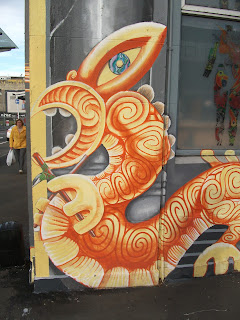 |
| Underground Arts Tattoo Studio |
Underground
Arts Tattoo Studio is a striking example of Postmodernism. As said by Charles
Jencks in his edited book The Post-modern
Reader; “post-modernism means the end of a single world view and… a
resistance to single explanations, a respect for difference and a celebration
of the regional, local and particular” (1992), something which Underground Arts
displays through the collection of cultural references and styles that make up
its design.
The actual
architecture of the building is most closely associated with the Art Deco
movement in its rigid geometric structure. The edges are softened by the
occasional curve and the base colour of the building is Deco beige. The design
becomes more “hybrid, mixed and ambiguous” (Jencks, 1992) with the addition of
painted on columns. These illusionistic columns fail to serve any purpose that
they would on other buildings as they do not provide any real support and the
choice to paint the grey instead of white removes any connection to the pure
white marble of classicism. The real irony is in the connections the columns
provide to classicism as a promotion of democracy, and the affiliations “the
modern man who tattoos himself [being] a criminal or degenerate” (A. Loos,
1910).
The bright
orange taniwha with the ancient Maori tattoo pick and the Chinese dragon with
the modern needle meet at the corner of the building to finalise this
post-modern clash of cultures and complete the “erosion of the older distinction between high culture and so-called mass or popular culture" (F. Jameson, 1991).
This style suits the shop as the art of tattooing has always been considered just that; an art. It is recognised and practised across many cultures and the cultural collage that is presented by Underground Arts represents the building and business superbly.
References:
Jencks, C., (1992). The Post-modern Reader. London: Academy Editions.
This style suits the shop as the art of tattooing has always been considered just that; an art. It is recognised and practised across many cultures and the cultural collage that is presented by Underground Arts represents the building and business superbly.
References:
Jencks, C., (1992). The Post-modern Reader. London: Academy Editions.
Adolf Loos, Ornament and Crime, excerpted in Gorman, C. (2003). The Industrial Design Reader (pp. 74 - 81). New York: Allworth Press.
Jameson, F., (1991). Post-modernism and Consumer Society, Athenaeum Library of Philosophy. Retrieved from



No comments:
Post a Comment